This page provides a number of layout design and automation concepts that Tomix and Tomytec could develop to provide additional TNOS automated operation possibilities for their customers.
The TNOS Layout Plans that Tomix have provided are generally very geometric and logical, and the operating sequences for them seem to be a Bach-like exercise in variations. Instead, I would like to see layout plans and operating sequences that are based more on the way real railways look and operate.
Modelers should remember that the simplistic geometric shapes that Tomix TNOS layouts are drawn in do not have to be the real shape of the layout. They are illustrated that way for simplicity. Using the basic, common-sense aspects of the study of topology, you can stretch, twist and reshape layouts and their elements, as long as you do not change the basic flow and sequence of the block sections. TNOS layouts work best, though, if the block lengths (actually the distances between successive sensors) are made as equal as possible.
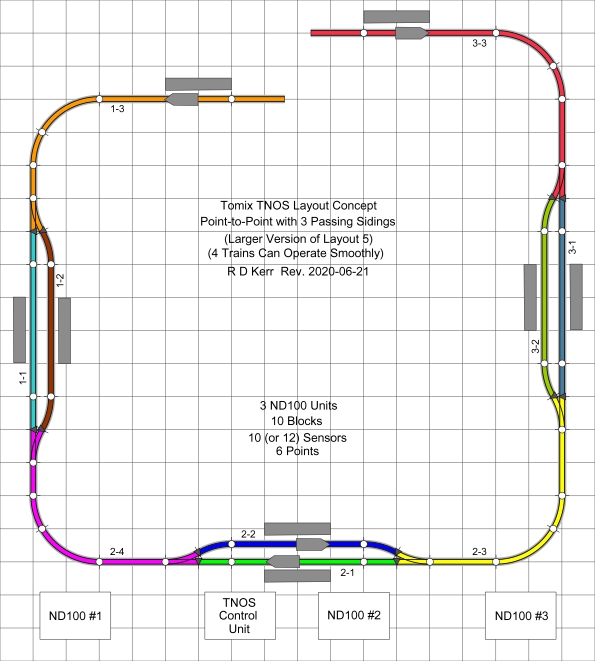
Concept 1: Point-to-Point with 3 Passing Sigings
Here is a point-to-point single track line with 3 sets of passing sidings along it. Four trains should be able to operate fairly smoothly on it, meeting and passing at the passing sidings. This layout arrangement would work for a great many prototypes, like the Enoden line or any single-track small railway or tram/trolley line. It requires 3 ND100 Hubs and it could use either one or two sensors in the end block sections of single track. I would like to see an operating sequence like that for this layout, with continuous repetition. One Automatic Operating sequence (for trains) could schedule stops at the stations, while another (for trams) would not require station stops, counting on traffic to make brief stops happen.
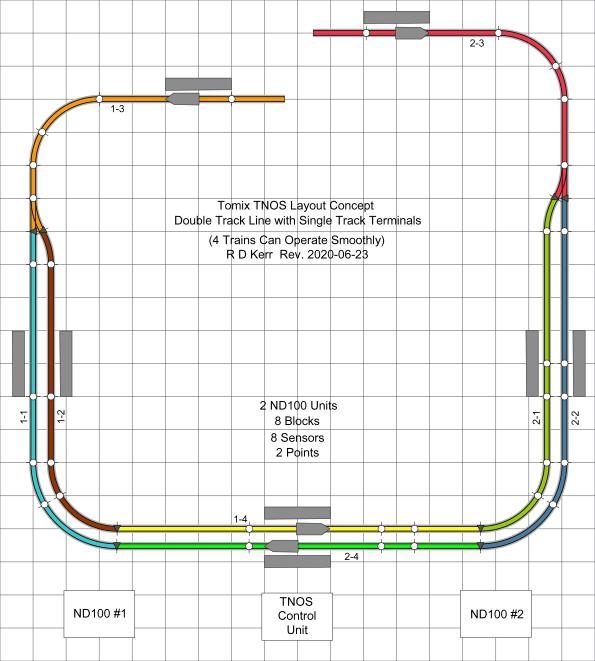
Concept 2: Double Track Line with Single Track Terminals
This Tomix TNOS layout concept is for a double-track railway line with single-track end terminals. A Japanese prototype example would be the Setagaya tram line. There are many other railways generally like this. This layout requires two ND100 Hubs and has eight block sections. Again, four trains or tram/trolleys could operate smoothly on this layout, and I would like operating sequences designed for continuous repetition, both with and without programmed station stops. Just press Start on the TNOS Control Unit and enjoy watching it run! Good for model railway show and convention exhibition layouts.
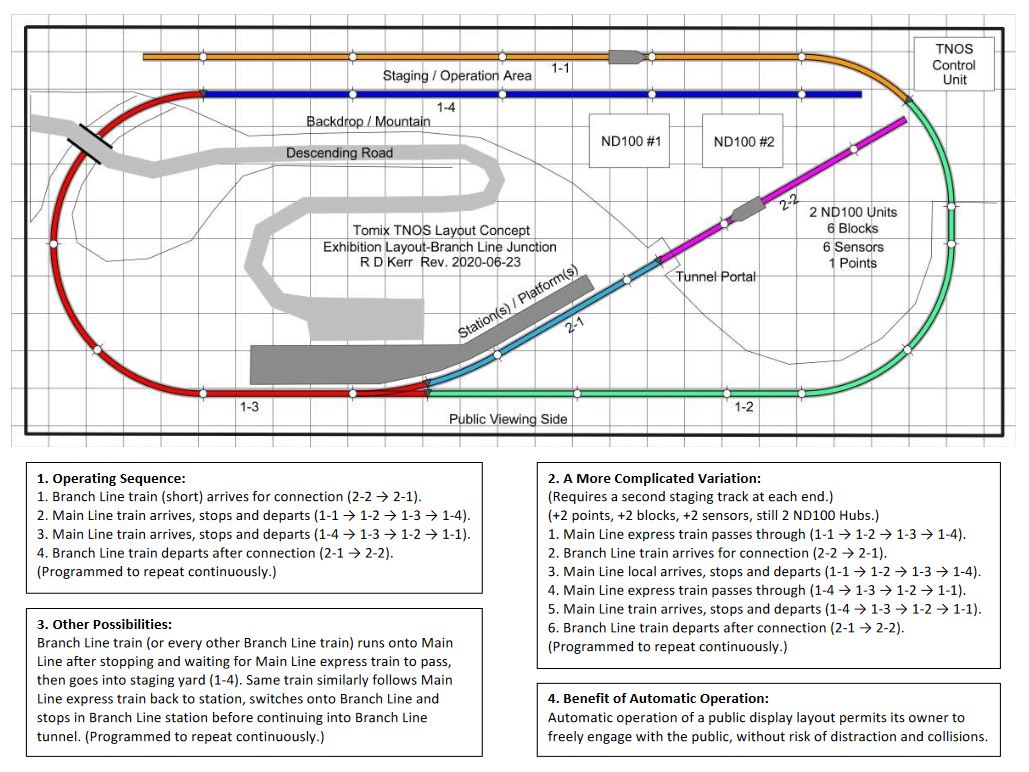
Concept 3: Exhibition Layout - Branch Line Junction
This TNOS layout concept is different from the earlier ones. It's a simple-looking, exhibition-style layout of a junction where a small branch line meets a single-track main line. It is set in a mountainous, or at least hilly, area to hide the rear staging track area and controls. The TNOS part has to do with automating the coordinated scheduling of the train on the main line and the smaller train (or single railcar) on the branch line. The layout and some explanation of a few possible operating scenarios are in the pdf file.
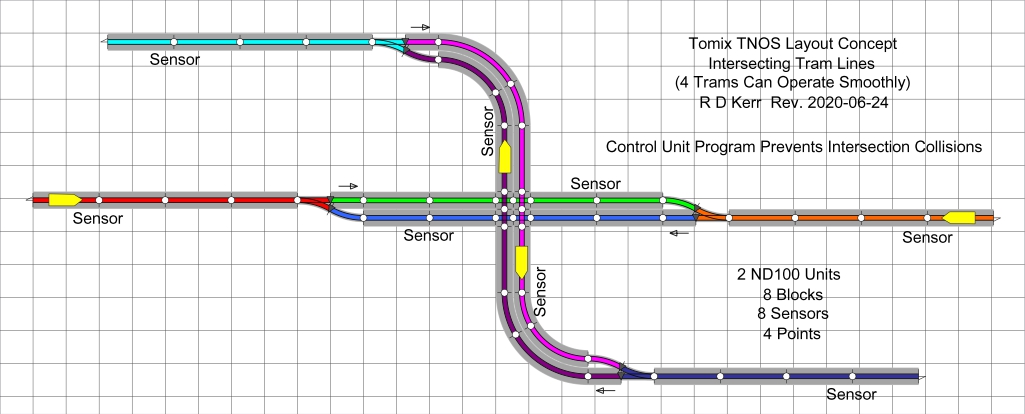
Concept 4: Intersecting Tram Lines
Here is a TNOS layout concept for 2 intersecting point-to-point tram/trolley lines. The center section of each line is double-track, so the intersection involves 4 crossing pieces. Two trams or trolleys run back and forth on each route, in a continuous operation. The TNOS Control Unit manages this and also keeps any intersection crashes from happening. The layout creates a lot of downtown action at the intersection. The sensors in the double-track sections are placed far enough beyond the intersection to ensure that the trolley or tram has cleared the intersection before reaching the sensor. (More sensors could be added, but I did not see any obvious benefit to doing this - perhaps to simply add more tram stops along the streets.) The Mini Point track switches (and related curve pieces) would need to be paved using the Tomix 3079 Street Paving Kit II. This kit (and not the original 3076) matches Wide Tram track in surface color and texture.
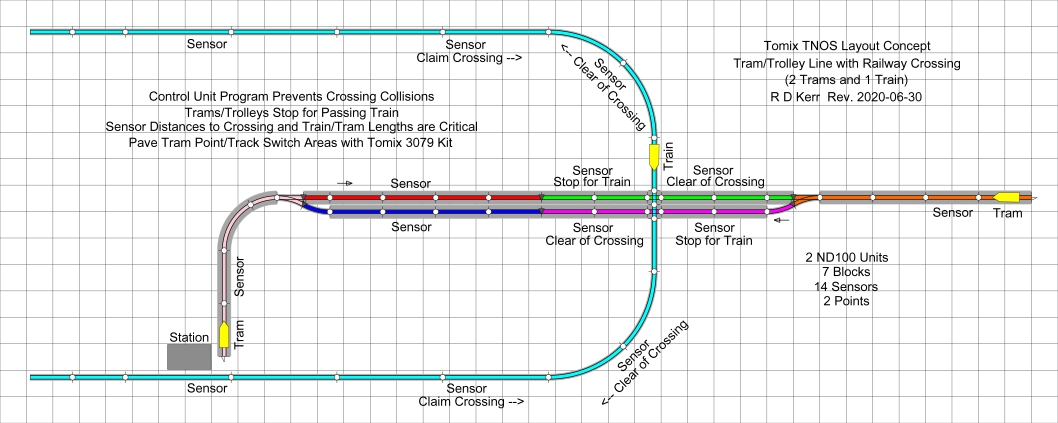
Concept 5: Tram / Trolley Line with Railway Crossing
This and the next Tomix TNOS concept layouts are related to each other. One is a tram/trolley line with a railway crossing, and the other is a railway line with a tram/trolley crossing. The difference is a matter of whether the tram line or the railway line is the main attraction, with the other line being more of an accessory. In the layout above, two trams or trolleys shuttle back and forth between the railway station and a city's outskirts, passing through the city itself on double tracks. Every so often, a train arrives and later departs from the railway station, and the trams have to stop at the crossing to let it pass. This can be safely handled by the TNOS logic. Shortly after leaving one end of the railway line, the train hits a sensor that "claims" the crossing, and sensors on the two tram tracks stop any trams that reach them, stopping before the crossing. The train crosses the tram line, and when it is completely clear of the crossing, it hits a sensor that lets any waiting trams cross the crossing. The "claiming" sensor is far enough away that any approaching tram can be triggered to stop short of the crossing, and any tram already within the crossing block when the "claim" is made will have enough time to clear the crossing and hit a "clear" sensor. The end-of-line time delay for the train to reverse direction and depart can be set to be fairly long, so the train only crosses intermittently to interrupt the tram line operation. Since there is only one train, the railway line can be a single block with multiple sensors. The non-station end could be hidden on the actual layout as a staging area.
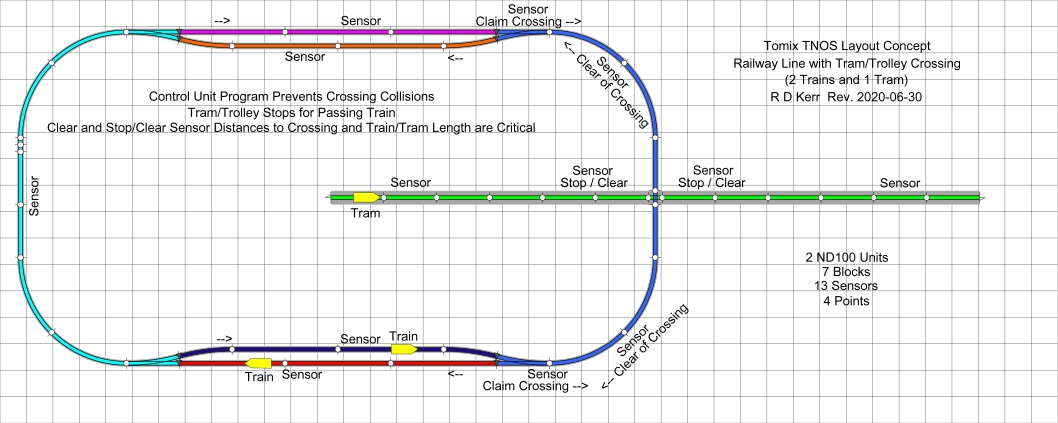
Concept 6: Railway LiIne with Tram / Trolley Line Crossing
In this plan the railway is the featured operation, with two trains circling in opposite directions and meeting at the passing sidings. The TNOS logic lets the single shuttle tram or trolley cross the crossing when it can, based on railway traffic. It's like a simplified version of several existing TNOS Layout Plans that have a loop and two passing sidings, with the tram line added by using freed-up block and sensor connections. Once again, the trains would run less frequently than the trams, as in real life. And in this case it is the tram line, with just a single tram on it, that can be a single block with multiple sensors. A total of three trams and trains can generally stay in motion on each of these layouts.
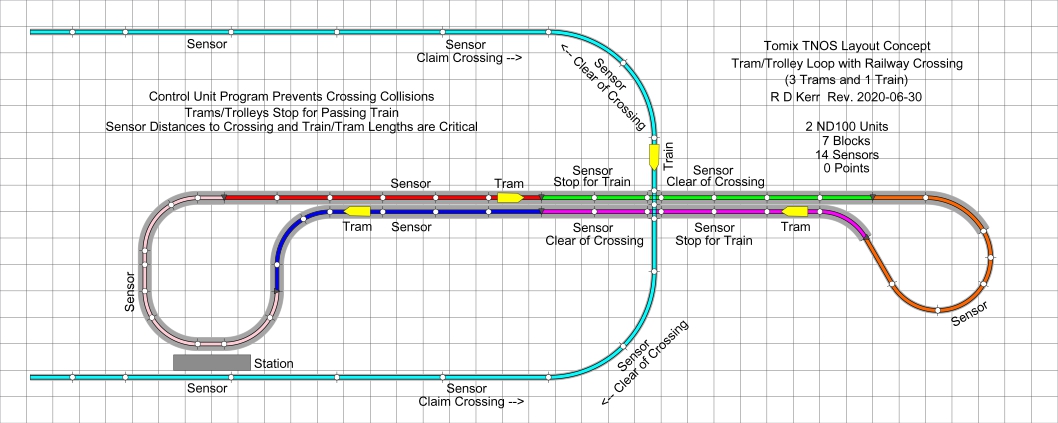
Concept 7: Railway Line with Tram / Trolley Line Crossing
Here is yet another variation on the tram line / railway line Tomix TNOS layout concept. This one has a double-track loop line for the tram, with the occasional train interrupting forward progress at the grade crossing. The tram/trolley line loops around a city block to serve the railway station. The tram line is much like the existing TNOS Layout Plan 8, except is has just 6 block sections instead of 8. Then 1 of the 2 remaining blocks can be allocated for use by the railway line. I think with a properly programmed operating sequence, and not too-frequent trains, that 3 trams could be operated fairly smoothly, plus the train. (The point-to-point tram line version above can only handle 2 trams smoothly.)
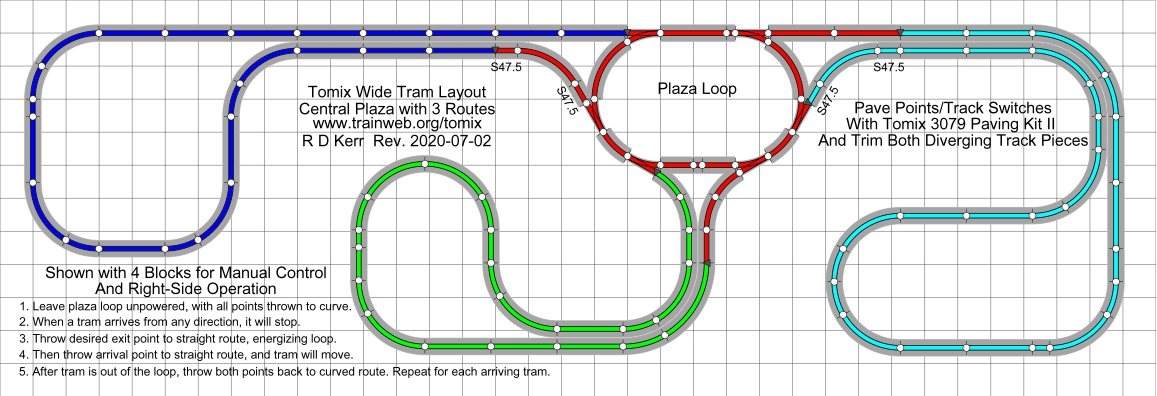

Concepts 8 and 9: Tram Line with Central Plaza
Here are two versions of a tram/trolley layout that I designed, built and operated manually several years ago. The upper layout is a three-line version, while the lower layout has a loop route. Both layouts feature a small oval circling around a plaza or park area, with tram lines then radiating out in different directions. Many, many towns and cities around the world have or had such a plaza, where tram lines would meet. I envisioned that the scenic backdrop to the model plaza would be the front of a large, imposing central railroad station building. I was able to design the small plaza loop, with 6 points/track switches, using Tomix Wide Tram track. It makes use of the otherwise pretty useless S47.5mm straight Wide Tram pieces. It was a lucky fit, and I am sure not a use that Tomix anticipated for this piece. I had to equally trim the interfering street paving on the two track pieces that form the diverging straight and curved point branches at each point/track switch. I used points paved with pieces from Tomix paving kits. The upper drawing shows the block gaps located for manual operation and right-side-of-road operation, making a stopping area at the plaza loop (normally turned off) on all approaches. The lower drawing has the insulating gaps placed for automatic operation. Either way, it's a busy little tram layout, with lots of activity.